 A FOOD FIGHT got underway today with dairy farmers and beef producers joining forces to fling facts in the face of food foes.
A FOOD FIGHT got underway today with dairy farmers and beef producers joining forces to fling facts in the face of food foes.
The main message is to Give Thanks for food and farmers as we prepare for the holiday season. Giving thanks can even get you a steak – actually, an Omaha Steaks Ideal Gift Collection of steaks and burgers valued at $135. Just leave a message of thanks for our farmers and ranchers here on the Pasture to Plate website. Producers can join the Beef Checkoff’s five-day FOOD FIGHT by visiting the
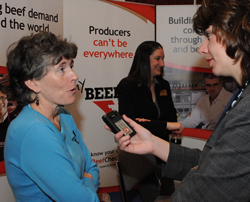 Cattlemen’s Beef Board chairman Lucinda Williams, a dairy producer from Massachusetts, was at NAFB Trade Talk last week talking about why livestock producers need to be armed with the facts to defend themselves against critics. “There’s an awful lot of people trying to tell our story,” Lucinda says. “This is our time to get out and tell our story.”
Cattlemen’s Beef Board chairman Lucinda Williams, a dairy producer from Massachusetts, was at NAFB Trade Talk last week talking about why livestock producers need to be armed with the facts to defend themselves against critics. “There’s an awful lot of people trying to tell our story,” Lucinda says. “This is our time to get out and tell our story.”
She says they are encouraging producers to get out an tell that story on Facebook and Twitter and email, (as well as traditional methods like actual face to face communication!) and encouraging everyone to give thanks for the safe and abundant food supply we enjoy in this country.
Listen to Chuck’s interview with Lucinda from NAFB here:

 The late harvest was one of the major topics of discussion for
The late harvest was one of the major topics of discussion for 
 This week’s ZimmCast features two interviews done at the
This week’s ZimmCast features two interviews done at the  We have been attending the NAFB convention since 1985 and some things never change – like Ted Haller, for example. But, other things – like Ted’s hair – do change, and in recent years that has been the emphasis on usage of the Internet and social media. Teddy presented us with findings from Internet Ag Information Usage Study that surveyed farmers and ranchers about their Internet access practices and preferences for agribusiness information, including use of the mobile Web. That study will be available on the NAFB website for members to access.
We have been attending the NAFB convention since 1985 and some things never change – like Ted Haller, for example. But, other things – like Ted’s hair – do change, and in recent years that has been the emphasis on usage of the Internet and social media. Teddy presented us with findings from Internet Ag Information Usage Study that surveyed farmers and ranchers about their Internet access practices and preferences for agribusiness information, including use of the mobile Web. That study will be available on the NAFB website for members to access. Meanwhile, Dr. Emily Rhodes of THE Ohio State University (who is also a Gator), did a study of farm broadcasters and journalists about their usage of the internet and social media tools like Facebook and Twitter. She had some interesting findings and her main message to the media was that utilizing these tools helps us reach new audiences to get the positive message about agriculture to the general public.
Meanwhile, Dr. Emily Rhodes of THE Ohio State University (who is also a Gator), did a study of farm broadcasters and journalists about their usage of the internet and social media tools like Facebook and Twitter. She had some interesting findings and her main message to the media was that utilizing these tools helps us reach new audiences to get the positive message about agriculture to the general public.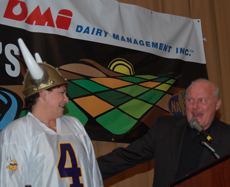 Outgoing National Association of Farm Broadcasting president Pam Jahnke – the one and only “Fabulous Farm Babe” – was honored and roasted by fellow members at the annual president’s banquet Friday night.
Outgoing National Association of Farm Broadcasting president Pam Jahnke – the one and only “Fabulous Farm Babe” – was honored and roasted by fellow members at the annual president’s banquet Friday night.
 Pam was joined by her saintly husband Buck and the rest of her family, including nephew Jayden – who seemed to find the Auntie Pam bobbleheads kind of scary!
Pam was joined by her saintly husband Buck and the rest of her family, including nephew Jayden – who seemed to find the Auntie Pam bobbleheads kind of scary! 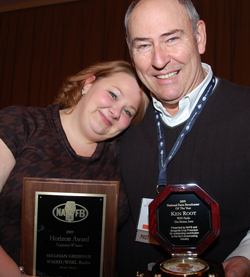 The National Association of Farm Broadcasting (NAFB) has named Ken Root of WHO as the 2009 Farm Broadcaster of the Year and Meghan Grebner of WMBD in Peoria is the Horizon Award winner this year.
The National Association of Farm Broadcasting (NAFB) has named Ken Root of WHO as the 2009 Farm Broadcaster of the Year and Meghan Grebner of WMBD in Peoria is the Horizon Award winner this year.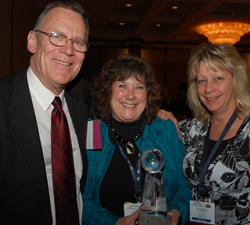
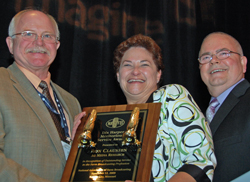 The man who took away the blue sheets with overlapping circles and put ag media research at your fingertips was honored by the National Association of Farm Broadcasting for Meritorious Service last night.
The man who took away the blue sheets with overlapping circles and put ag media research at your fingertips was honored by the National Association of Farm Broadcasting for Meritorious Service last night.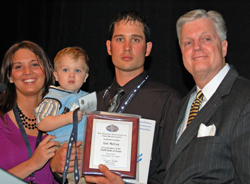 Two great farm broadcasters and people we are proud to call close friends were inducted into the NAFB Hall of Fame Thursday night in Kansas City.
Two great farm broadcasters and people we are proud to call close friends were inducted into the NAFB Hall of Fame Thursday night in Kansas City.  Our buddy Evan Slack was also inducted, joining many fellow long-time NAFBers and former presidents who are still active after more than five decades in the business. Evan made a point to tell everyone how important his iPhone is in continuing to do his job as a busy farm broadcaster!
Our buddy Evan Slack was also inducted, joining many fellow long-time NAFBers and former presidents who are still active after more than five decades in the business. Evan made a point to tell everyone how important his iPhone is in continuing to do his job as a busy farm broadcaster! 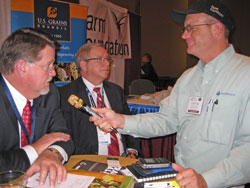 My first stop at the NAFB Trade Talk was the
My first stop at the NAFB Trade Talk was the